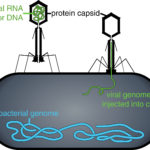Wrong on Viruses
Ephesians 5:6
“Let no man deceive you with vain words: for because of these things cometh the wrath of God upon the children of disobedience.”
 When studying popular-style articles about evolution, it is as important, if not more important, to study their use of language as it is to check the science. It is frequently the case that such an article needs to admit that previous thoughts on the subject were all wrong, but they cannot admit this; otherwise, their support for evolution would be in doubt. It is so often assumed that the theory of evolution is a large edifice that has exact things to say on a variety of life forms, but, in practice, there is considerable confusion even over their own ideas, leading to much dissemblance in their use of language. We have mentioned before that one of the most common linguistic constructions used in such articles is what some have called “fuzzy words”. These are words and phrases, whereby the author manages to make an insinuation about evolution without committing themselves openly to where they stand.
When studying popular-style articles about evolution, it is as important, if not more important, to study their use of language as it is to check the science. It is frequently the case that such an article needs to admit that previous thoughts on the subject were all wrong, but they cannot admit this; otherwise, their support for evolution would be in doubt. It is so often assumed that the theory of evolution is a large edifice that has exact things to say on a variety of life forms, but, in practice, there is considerable confusion even over their own ideas, leading to much dissemblance in their use of language. We have mentioned before that one of the most common linguistic constructions used in such articles is what some have called “fuzzy words”. These are words and phrases, whereby the author manages to make an insinuation about evolution without committing themselves openly to where they stand.
For example, a recent article about the possible evolution of bacterial viruses looked at how some viruses can alter the way that they attack their hosts, so that they can attack a different type of host. This would be how certain viruses can cross species. The article tried to describe how such viral innovation could have evolved, thus:
Researchers… have discovered evidence for a new path of evolution, and with it a deeper understanding of how quickly organisms such as viruses can adapt to their environment.
This “deeper understanding” really means to rewrite all that they knew on the subject. Happily, God’s word never changes in this way. Author: Paul F. Taylor
Prayer: We thank You, Lord, that You gave us the Bible, which uses language clearly, without dissembling. Help us to judge all that we encounter by the lens of Your word. Amen.
Ref: University of California – San Diego. “Virus found to adapt through newly discovered path of evolution: Innovation allows viruses to test drive new functions and evolve more easily than previously believed possible.” ScienceDaily. ScienceDaily, 29 March 2018. <www.sciencedaily.com/releases/2018/03/180329141037.htm>. Image: Thomas Splettstoesser; license: Creative Commons Attribution-Share Alike 3.0 Unported.